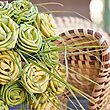Gullah Culture originates from the descendants of West Africans that were brought to the Lowcountry. This area stretches from North Carolina to Florida, with the South Carolina islands being the most populated. Edisto Island is home to the Gullah culture, and their presence is evident throughout daily life and is part of the Island’s cultural identity.
The Gullah people were brought from the coast of West Africa because of their superior skill set for growing rice. Once they arrived in America, they were enslaved and forced to work the rice plantations.
Plantation owners often left the Gullah people alone during the summer and rainy seasons due to the rapid spread of yellow fever and malaria. The plantation owners feared the diseases and left the Gullah people in charge of the rice fields.
The combination of being isolated on the coast away from the mainland and being left alone allowed the Gullahs to stay true to their traditions which include their family values, food, language, music, spirituality, and art.
The Gullah people could preserve their African heritage more than any other African-American community throughout the entire United States.
They are the largest group of Africans that were enslaved and brought to South Carolina. This region was referred to as the Rice Coast. Their rice-growing techniques, knowledge, and hard work were beneficial, and by the middle of the 18th Century, the Lowcountry was filled with rice fields.
During the beginning of the U.S. Civil War, the Union attempted to block Confederate shipping, which caused the white plantation owners located on the rice coast to abandon their land and flee to the mainland. The owners left the Gullah people behind to fend for themselves.
In 1861, the Union forces arrived at the Sea Islands and found the Gullah people eager to defend the land as well as their freedom.
As the Union-occupied Beaufort, many Gullahs served in the Union Army’s First South Carolina Volunteers. Since the slaves who lived in the Beaufort Sea Islands were freed first, missionaries from Pennsylvania arrived to start schools to help educate the slaves. The first school established is now known as Penn Center and is located on St. Helena Island.
Once the Civil War ended, the Gullahs were isolated again from the outside world and had little contact with those on the mainland. They continued to keep their traditions from outside influences into the 20th Century.
Gullah Language
English-based creole derived from a combination of languages from West Africa, Central Africa, and English. One interesting theory is the Gullah language was developed by combining phonological, grammatical, and lexical features of nonstandard English.
Another theory involves enslaved Africans already speaking West African Pidgin English before they arrived in America. This Guinea Coast Creole English was just one language spoken in West Africa and along the coast during the 17th, 18th, and 19th centuries. This language was often used to communicate with Europeans and was prevalent in coastal slave-trading centers.
The Gullah language is similar to the Afro-Seminole Creole spoken in Black Seminole communities in Northern Mexico, Texas, and Oklahoma. This is due to some Gullahs relocating after the Second Seminole War. However, the debate among linguists regarding the origin of the Gullah language continues to this day.
Gullah Food
Delicious cuisine that is fresh from the ocean is an excellent way to describe Gullah food. Many dishes include a fusion of local ingredients such as okra, rice, watermelon, crab, fish, oysters, shrimp, grits, yams, peas, beans, and more.
Gullah recipes are one of the oldest traditional foods being practiced in the United States today. The tradition came from the Gullah people being enslaved and having to “make do” with available resources.
Many Gullah people lived in conditions that only allowed them to have access to one pot. This means many recipes are one-pot meals that involve unique flavors and a combination of protein, rice, vegetables, and seasoning.
A popular recipe still enjoyed today is Frogmore stew, including sausage, potatoes, corn, shrimp, blue crabs, and other fresh seafood.
Gullah recipes can be found in restaurants throughout Edisto Island and are considered the favorite of many locals and visitors.
Gullah Art
The Gullah people brought their talents, landscape design, fabric, architecture, basket art, and other forms of vibrant artwork to Edisto Island. The men did elaborate wood carvings for monuments, created walking sticks and human figures.
Most of the Gullah women kept the tradition of sweetgrass basket making alive and sewed beautiful quilts. The practice of basket-making is passed down through the generations and only taught in person.
Other convenient artistic items include palm leaf brooms, clay pots, handmade cotton blankets, and calabash containers.
Gullah paintings have vibrant colors and deep meaning. Paintings usually show life scenes such as daily experiences. They are often vivid, beautiful, and evoke feelings.
Gullah Music
Gullah music comes from pure West African Chants that have influenced today’s blues, jazz, and spiritual harmony. When the enslaved people sing, the beautiful sound would transcend them to another place and give a small amount of peace for just a few moments.
The singing united the community and helped everyone work together at the same pace to get their work done. Sometimes, the songs would contain hidden messages related to the underground railroad and other important information that the Gullahs needed to communicate.
Spirituals were also about events in the Bible, or a story created based on the Bible’s stories.
Modern Day Gullah in Edisto
Today Edisto is home to a large Gullah community that honors their ancestors and sticks to authentic traditions. Some plantations have been redeveloped as resorts to welcome tourists along the coast. The Gullah culture is inspiring, deep, meaningful, and filled with history that dates back to the 1500s.
Visiting Edisto Island is a must to allow yourself to indulge in this great culture and experience the authentic food, music, art and love this culture brings to the world.













